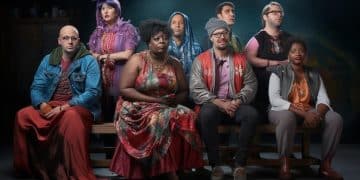From Book to Screen: Comparing Adaptations of Popular Novels into Series

Comparing adaptations of popular novels into series reveals a complex interplay between source material fidelity and creative reimagination, often sparking debate among fans regarding character portrayal, plot alterations, and thematic depth, ultimately influencing viewer reception and critical acclaim.
Diving into the world of storytelling, exploring the journey From Book to Screen: Comparing Adaptations of Popular Novels into Series offers a fascinating perspective on how narratives evolve across different mediums. This analysis uncovers the delicate balance between upholding the essence of a beloved book and reimagining it for a visual audience.
The Allure of Adaptation: Why Books Become Series
The transition of a beloved book into a serialised television format is a phenomenon that continues to captivate audiences and creators alike. It’s not merely a trend but a testament to the enduring power of storytelling and the vast potential for narratives to transcend their original forms. This process is complex, involving intricate decisions that shape the final product, often leading to fervent discussions among dedicated fans.
Understanding the Drive for Series Adaptations
One primary reason behind the surge in book-to-series adaptations is the ready-made audience. Bestselling novels arrive with an established fanbase, eager to see their cherished characters and worlds brought to life. This built-in audience significantly reduces the marketing risk for studios and streaming platforms, making such projects highly attractive investments. Moreover, these adaptations offer a unique opportunity to explore beloved stories in greater depth.
- Pre-existing Fanbase: A novel’s popularity guarantees an initial viewership.
- Rich Source Material: Detailed books offer extensive narrative arcs and character backstories, ideal for multi-season shows.
- Lower Creative Risk: The story’s success is already proven, reducing the speculative nature of new content.
- Brand Recognition: Established titles bring immediate recognition and often critical interest.
The serialized format of television also allows for a more expansive narrative. Unlike movies, which condense complex plots into a few hours, series can delve into subplots, develop minor characters, and explore themes with a nuanced pace that mirrors the reading experience. This extended runtime becomes an invaluable asset for adaptations of lengthy or complex literary works, ensuring that little is lost in translation.
Furthermore, the creative freedom afforded by streaming platforms has opened new avenues for diverse storytelling. There is a willingness to invest in ambitious projects that might have been deemed too niche or too challenging for traditional film releases. This shift supports adaptations that are more faithful to the source material, even those that feature unconventional narratives or settings, truly enriching the viewing landscape.
Fidelity vs. Creative Freedom: The Core Dilemma
The tension between remaining true to the source material and exercising creative freedom is the perennial debate for any adaptation. This dilemma lies at the heart of every book-to-screen project, influencing all creative decisions from casting to plot development. Striking the right balance is crucial for success, as straying too far can alienate fans, while too much rigidity can hinder artistic innovation and broader appeal.
Navigating the Adaptation Spectrum
Some adaptations aim for near-absolute fidelity, meticulously recreating scenes, dialogue, and character arcs as described in the book. This approach often appeals to purist fans who prioritize precise adherence to the original text. However, even the most faithful adaptations must make concessions due to the inherent differences between literary and visual storytelling.
- Direct Dialogue: Replicated word for word from the book.
- Scene Reconstruction: Visual layout mirroring book descriptions.
- Character Portrayal: Actors embodying traits and mannerisms as written.
- Plot Arc Adherence: Main storyline and key events remain unaltered.
Conversely, other adaptations embrace significant creative liberties, often reimagining aspects of the plot, character backstories, or even the setting to suit a modern audience or to explore new thematic interpretations. While this can sometimes lead to groundbreaking and critically acclaimed series, it also carries the risk of alienating the source material’s initial fanbase, who may feel their beloved story has been disrespected or fundamentally altered.
Ultimately, a successful adaptation often manages to capture the spirit and essence of the book, even if it deviates from the letter of the text. It understands what made the book special to its readers and translates those core elements into a compelling visual narrative. This involves a deep understanding of the source material’s thematic underpinnings and an ability to translate literary techniques into cinematic language, ensuring the story resonates anew.
The best adaptations understand that fidelity does not always mean a word-for-word copy. Instead, it means capturing the emotional core, the character’s journey, and the underlying messages that made the original work impactful. This balance is an art form, requiring talented writers, directors, and actors who can interpret, rather than merely transcribe, the source material.
Characters and Casting: The Face of Familiarity
The portrayal of characters is arguably one of the most critical aspects of any book-to-series adaptation. For readers, the characters are often the soul of the story, and their visual representation on screen can make or break an adaptation’s reception. The casting process, therefore, becomes an intensely scrutinized affair, with fans holding strong opinions about who should embody their literary heroes and villains.
The Weight of Fan Expectations
When a beloved book character transitions from the pages of a novel to the screen, fan expectations run incredibly high. Readers have already formed vivid mental images and emotional connections with these characters, shaped by their own imaginations. Discrepancies in appearance, voice, or even general demeanor can be jarring, leading to disappointment or even backlash from the fanbase.
- Physical Appearance: Matching descriptions of hair, eye color, and stature.
- Voice and Tone: Capturing the character’s unique vocal qualities.
- Essence and Personality: Portraying the core traits that define them.
- Chemistry with Others: Ensuring believable relationships with co-stars.

Beyond physical resemblance, actors must skillfully capture the psychological depth and emotional complexity that made characters resonate in their original form. A truly successful portrayal goes beyond superficial traits, delving into the nuanced motivations, internal conflicts, and emotional arcs that drive the character’s journey. This requires not just acting prowess but a profound understanding of the source material.
The casting director’s role is pivotal here, tasked with finding actors who not only fit the physical descriptions but can also embody the spirit of the characters. Sometimes, an actor who doesn’t precisely match the book’s description can still deliver an iconic performance that transcends initial fan concerns, proving that talent and understanding of the role can be more important than strict physical adherence.
Ultimately, the success of character portrayal in adaptations often hinges on a delicate balance: honoring the reader’s imagined version while also allowing the actor and director the creative space to bring a fresh, compelling interpretation to life. When this balance is struck, iconic literary figures gain new life on screen, cementing their place in both literary and cinematic history.
Pacing and Plot: Spreading a Story Across Seasons
Adapting a novel into a series inherently changes the pacing and structural rhythm of the story. A book, often designed for a continuous reading experience, might feature a rapid plot progression or a more reflective, slow burn. Translating this to a serialized format involves breaking the narrative into episodes and seasons, each with its own arc, while maintaining momentum towards a grander conclusion. This architectural challenge is fundamental to serial adaptation.
Adjusting Narrative Flow for Television
Unlike a film, which has a finite runtime to tell its story, a series allows for extensive development. This can be a significant advantage for sprawling novels with multiple viewpoints or complex political landscapes. Each episode can explore character backstories, delve into subplot intricacies, or dedicate time to world-building that would be impossible in a feature film. However, this extended format also brings the challenge of maintaining audience engagement over many hours of content.
- Episode Cliffhangers: Ending each episode with tension to encourage continued viewing.
- Season Arcs: Developing compelling overarching plots for each season.
- Character Deep-Dives: Allocating time for extensive character progression.
- World-Building Details: Gradually revealing the intricacies of the fictional universe.
One common approach is to expand on existing storylines or even introduce entirely new ones to fill out seasons. While this can provide fresh content for viewers, it can also lead to “filler” episodes that deviate from the core narrative, potentially frustrating fans who prefer a direct adaptation. The key is to ensure any additions or expansions genuinely serve the story and characters, rather than simply padding the runtime.
The pacing of a book translated to series often sees some storylines compressed and others expanded. Critical events might be spread across several episodes to maximize dramatic impact, while less crucial details might be streamlined or omitted. This selective approach is vital for ensuring that the series feels dynamic and engaging, rather than a mere recitation of the novel’s plot points.
Ultimately, the art of successful series adaptation in terms of pacing and plot lies in understanding the strengths of the episodic format. It’s about leveraging the extended runtime for deeper exploration while carefully structuring each season to provide satisfying narrative momentum, ensuring viewers remain invested in the journey from beginning to end.
Success Stories: When Adaptations Shine
Amidst the challenges and debates, numerous adaptations have transcended their literary origins to become critical and popular successes, proving that the journey From Book to Screen: Comparing Adaptations of Popular Novels into Series can indeed lead to cinematic triumphs. These success stories often achieve a delicate balance: respecting their source material while confidently forging their own identity as visual narratives. They become benchmarks for what a great adaptation can be.
Defining Qualities of Outstanding Adaptations
What makes an adaptation truly shine? It often begins with a deep reverence for the source text, understanding its nuances, themes, and what made it resonate with readers. This profound respect then provides a solid foundation from which creative interpretation can emerge. The best adaptations don’t just copy; they interpret, elevate, and sometimes even clarify aspects of the original story in ways that only a visual medium can.
- Deep Source Material Understanding: Grasping the soul of the book.
- Compelling Visual Storytelling: Translating literary imagery effectively.
- Exceptional Casting: Actors who embody their roles flawlessly.
- Strong Direction and Writing: A creative team that delivers a cohesive vision.
Look at “Game of Thrones” (based on George R.R. Martin’s “A Song of Ice and Fire”) in its prime. While it eventually diverged significantly from the books, its early seasons were celebrated for their meticulous world-building, complex character arcs, and high production values that brought Westeros vibrantly to life. It showcased how a sweeping fantasy epic could be adapted without losing its intricate detail or moral ambiguity.

“The Handmaid’s Tale,” based on Margaret Atwood’s dystopian novel, is another prime example. While the series expands significantly on the events of the book—especially beyond its original ending—it does so in a manner that feels authentic to Atwood’s vision, exploring the world of Gilead with chilling relevance and artistic bravery. It demonstrates how an adaptation can extend a narrative without compromising its core message or thematic power.
These successful series often share qualities like intelligent writing, exquisite costume design, evocative cinematography, and a soundtrack that enhances the narrative. But perhaps most importantly, they manage to surprise and delight both devoted readers and new audiences alike, demonstrating that a story, when told with skill and passion, can find new life and new meaning across different media.
Challenges and Criticisms: When Adaptations Falter
While the allure of bringing beloved novels to the screen is undeniable, the path is fraught with challenges, and not every adaptation achieves the hoped-for success. The journey From Book to Screen: Comparing Adaptations of Popular Novels into Series also reveals instances where projects falter, attracting significant criticism from fans and critics alike. Understanding these pitfalls offers valuable insights into the complexities of visual storytelling and fan expectations.
Common Reasons for Disappointment
One major source of criticism often stems from significant deviations from the source material. When an adaptation alters fundamental plot points, dismisses key character traits, or introduces elements that feel inconsistent with the original author’s vision, it can alienate the very fanbase it sought to attract. This perceived betrayal of the book’s essence can be difficult for fans to overlook, leading to widespread dissatisfaction and often, premature cancellation.
- Plot Alterations: Major storyline changes that detract from the original narrative.
- Miscasting: Actors not embodying the spirit or appearance of beloved characters.
- Pacing Issues: Too slow, too fast, or inconsistent narrative rhythm.
- Underdeveloped Characters: Losing the depth and complexity present in the book.
Another frequent point of contention is miscasting. When an actor fails to capture the essence of a cherished character, or simply doesn’t fit the established mental image of the character, it can be a significant barrier to viewer immersion. Even strong writing and direction can struggle to overcome a fundamental disconnect between the actor and the role, as fans often project strong expectations onto these visual representations.
Moreover, pacing issues can severely impact an adaptation’s reception. Some series struggle with stretching a thin narrative across too many episodes, leading to sluggish plot development and “filler” content that bores audiences. Conversely, attempting to condense a rich, multi-layered novel into a limited number of episodes can result in a rushed, superficial narrative that sacrifices depth and nuance for brevity, leaving viewers feeling unsatisfied.
Poor production quality, a lack of cohesive vision from the creative team, or simply misunderstanding the core appeal of the source material can also contribute to an adaptation’s downfall. Ultimately, a successful adaptation avoids these pitfalls by balancing creative innovation with a deep understanding and respect for the original work, ensuring that the visual narrative enhances rather than diminishes the beloved story.
The Future of Adaptations: A Symbiotic Relationship
Looking ahead, the relationship between novels and their serialized screen adaptations is evolving into an increasingly symbiotic one, where each medium influences and enriches the other. The journey From Book to Screen: Comparing Adaptations of Popular Novels into Series is not a one-way street, but rather a dynamic interplay that continues to shape our cultural landscape. This synergy hints at exciting possibilities for how stories will be told and consumed in the years to come.
Emerging Trends and Collaborative Narratives
With the continued expansion of streaming services and the demand for fresh, compelling content, the appetite for adaptations remains voracious. Creators are now exploring new ways to engage with source material, moving beyond traditional interpretations to embrace more innovative narrative structures and character developments. This includes interactive elements, prequels, sequels not directly based on existing books but approved by authors, and even multiple adaptations of the same book, offering varied perspectives.
- Author Involvement: Increased participation of original authors in screenwriting and production.
- Transmedia Storytelling: Expanding narratives across games, podcasts, and digital content.
- Diverse Interpretations: Allowing multiple screen versions of a single book.
- Fan-Driven Content: Incorporating feedback and theories from dedicated fan communities.
There’s also a growing trend towards greater involvement of original authors in the adaptation process, moving beyond a mere “rights acquired” transaction. Authors are increasingly taking on roles as executive producers, consultants, or even screenwriters, ensuring that their creative vision is accurately and respectfully translated. This collaborative approach can lead to adaptations that feel more authentic and resonant with the original spirit of the work.
Furthermore, adaptations often breathe new life into older or lesser-known literary works, bringing them to a wider audience. A successful series can spark a resurgence in book sales, prompting new printings and introducing classic stories to a generation that might not have discovered them otherwise. This demonstrates the powerful cross-promotional effect that symbiotic relationships can generate within the entertainment industry.
The future of adaptations promises a richer, more diverse tapestry of storytelling, where books and series continue to inspire and elevate each other. As technology advances and creative boundaries blur, we can expect even more inventive and deeply immersive experiences From Book to Screen: Comparing Adaptations of Popular Novels into Series, solidifying this dynamic as a cornerstone of modern entertainment.
| Key Aspect | Brief Description |
|---|---|
| 📚 Source Fidelity | How closely the series adheres to the original book’s plot and themes. |
| 🎭 Character Portrayal | The success of casting and acting in bringing literary characters to life. |
| ⏱️ Pacing & Plot | How the narrative rhythm and story structure adapt to episodic TV. |
| 🌐 World Building | Visual and narrative expansion of the book’s universe in the series. |
Frequently Asked Questions about Book-to-Screen Adaptations
▼
A successful book adaptation skillfully balances fidelity to the source material with creative innovation, capturing the book’s core essence while making necessary adjustments for the visual medium. Strong performances, intelligent writing, and compelling visuals are also crucial, alongside a clear understanding of what made the original story resonate with its readers.
▼
Adaptations may diverge for several reasons, including creative freedom to tell a new story, updating themes for a modern audience, or the practicalities of television production. Sometimes, a book’s internal monologue or complex narrative structure is challenging to translate directly, necessitating changes to maintain viewer engagement and cinematic flow.
▼
Casting is immensely important. Actors must embody both the physical characteristics and the profound emotional depth of beloved literary characters. A charismatic and believable portrayal can elevate an entire series, whereas a perceived miscast can significantly impact fan reception and critical success, often becoming a primary point of discussion.
▼
While subjective, some argue that a series adaptation can enhance a novel by expanding underdeveloped plot lines, clarifying ambiguities, or deepening character backstories that were briefly touched upon in the book. Visual and auditory elements can also add new dimensions to the immersive experience, potentially enriching the original narrative in unexpected ways.
▼
The author’s involvement varies widely. Some authors prefer minimal input after selling the rights, while others become deeply engaged as executive producers or consultants. Their role often depends on their interest, contract terms, and the production team’s desire for their input to maintain the integrity and spirit of the original literary work.
Conclusion
The journey From Book to Screen: Comparing Adaptations of Popular Novels into Series is a complex and captivating endeavor, showcasing the dynamic interplay between literary artistry and cinematic interpretation. While striking the perfect balance between fidelity and creative freedom remains a perennial challenge, the best adaptations stand as testaments to the enduring power of storytelling, enriching narratives for both loyal readers and new audiences alike. As the landscape of media consumption continues to evolve, the symbiotic relationship between novels and series promises an exciting future for shared stories, bridging the gap between imagination and visual reality.





